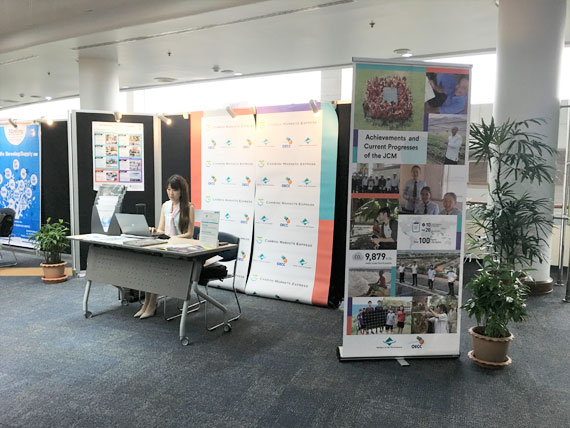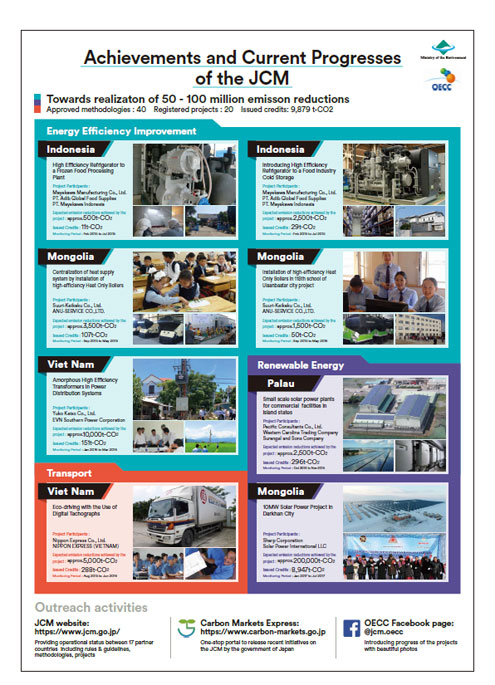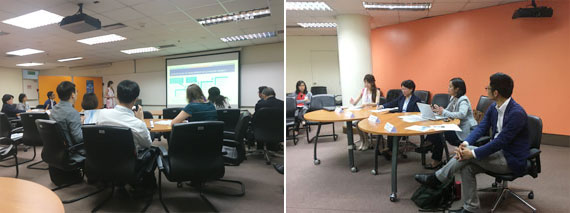APCF 2017: Booth Exhibition and Side Event
Asia Pacific Carbon Forum 2017 in Bangkok, Thailand
Booth exhibition
The 2017 Asia Pacific Carbon Forum (APCF 2017) was held in Bangkok, Thailand on December 13-15, 2017 as one part of the Asia-Pacific Climate Week (APCW 2017). The APCF 2017 was co-organized by the Asian Development Bank (ADB), the International Emissions Trading Association (IETA), the United Nations Framework Convention on Climate Change (UNFCCC), and the Institute for Global Environmental Strategies (IGES).
The Overseas Environmental Cooperation Center, Japan (OECC) set up a display booth within the APCF 2017 venue, where it displayed and distributed a variety of materials relating to the JCM and provided information to visitors. Around 40 people visited the OECC’s display booth over the three-day period.
The APCF 2017 was notable for the number of private-sector companies that visited to gather information on the JCM, having apparently perceived the mechanism as offering new business opportunities. For that reason, there were a large number of specific questions posed that eyed the possibility of cultivating projects that utilize the JCM, including questions regarding the latest trends and the criteria for participating in JCM projects.

Reference
Overview of the opinion exchanges with visitors
Meetings were held with about 20 individuals, including government officials and representatives from international organizations and research organizations based in JCM partner countries, as well as offset providers and representatives of government organizations from South Korea, Singapore, the United States and India, which are taking note of the JCM as a representative example of the cooperative approach mentioned in Article 6, Paragraph 2 of the Paris Agreement, and project developers in the process of formulating projects in various countries. An overview of the opinion exchanges with visitors is as follows.
- – Overview of the JCM and the latest trends
- – The method by which the JCM is administered (to use as a reference for designing other, similar systems)
- – The uses and attributes of JCM credits, and the trading method
- – The trading price of JCM credits in Japan
- – The potential for applying projects currently being formulated by project developers to the JCM
- – Progress with the 100 or more projects that are currently being implemented (the schedule for implementing validation and verification)
- – The benefits of participating in the JCM for project implementers
- – The differences vis-a-vis the criteria for participating in the Clean Development Mechanism (CDM)
- – The emissions trading system
Private-sector companies that are observing progress with JCM projects via this website and other channels expressed strong interest in the uses of the approximately 10,000 tons of JCM credits* that have been issued from eight projects thus far. The OECC shared frontline input, including the JCM credit distribution ratios by Japan and its partner countries, and the main ways that credits are being utilized by project participants of the JCM.
* As of December 2017. For the latest credit issuance situation please refer to the JCM website.

Poster introducing projects for which JCM credits were issued.
Based on the large number of technical questions received from visitors with a fundamental understanding of the JCM, it was revealed that the JCM is at the stage of gaining traction to a certain extent as a system that enjoys some recognition in the international carbon market, and is being closely watched for the impact it will have on the carbon market.
Side Event “Innovation, Deployment, and Transfer of Low-Carbon Technology Through the Joint Crediting Mechanism (JCM)”
The Overseas Environmental Cooperation Center, Japan (OECC) held an APCF side event on “Innovation, Deployment, and Transfer of Low-Carbon Technology Through the Joint Crediting Mechanism (JCM).”
At this side event, a case of OECC’s horizontal expansion of a Vietnam project into Southeast Asia and a ratchet-up mechanism toward sustainable business development were introduced. A representative from the Thailand Greenhouse Gas Management Organization (TGO), which is the JCM’s contact point in JCM partner country Thailand, along with a representative who carries out MRV support for the JCM at IGES were invited as panelists to discuss the progress and expectations relating to the implementation of the JCM.

In addition to government representatives and specialists from various countries, around 20 operators considering utilizing the JCM participated in the side event, resulting in a bidirectional discussion of active questions and answers. In those questions and answers, many the questions that were posed were asked from operators’ standpoints, which would seem to infer that they are eyeing the possibility of formulating projects that utilize the JCM.
Overview of the opinion exchanges with visitors
- – The process up to discovering JCM projects
- – The process, time and cost up to registering JCM projects
- – The reason for the success with incorporating outstanding low-carbon technologies in the specifications for local procurement standards in Vietnam via JCM projects
- – Details of energy conservation technologies employed in the JCM
- – Comparisons with the Clean Development Mechanism (CDM) and the Gold Standard
Date and Time
Thursday, 14 December 2017, 10:30-11:30
Venue
Meeting Room 4, United Nations Conference Centre (Bangkok, Thailand)
Organizer
Overseas Environmental Cooperation Center, Japan (OECC)
Side Event Report
Program
|
|
|
|
|
|
|

